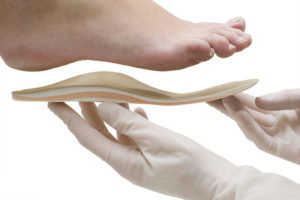I hear all too often that a client has been to see a podiatrist, had moulds taken of their feet and spent lots of money on customised foot orthoses, only to find they hardly wear them because their soft or hard foot orthotics are either too bulky for their shoes or too hard for their feet.
This issue can occasionally comes down to miscommunication between the podiatrist and client.
When the podiatrist prescribes a customised foot orthoses it is very important to discuss the range of footwear you are wanting to wear your foot orthoses in.
Your expectations and the activities you will be preforming with your customised foot orthoses is also important to discuss, as this will impact on the type of orthotic prescribed.
Understanding and following the wearing in process properly is vital, to allow enough time for your feet and body to adjust to the new orthotics in your shoes.
Soft or Hard Foot Orthotics?
So what is a best option for you? Soft or hard foot orthotics? How do you know if you should have a hard plastic (polypropelene) orthotic or a soft (Ethyl Vinyl Acetate, EVA) orthotic made for your feet?
Well this will depend on a few pros and cons for each, that the podiatrist should discuss with you, but in the mean time here is a summary of some of the differences between the two to help you decide.
Ethyl Vinyl Acetate (Soft Device) Pros:
- Very comfortable, soft and easier to adjust to and wear in.
- Can provide more padding for arthritic joints.
- Less likely to rub and cause blisters with certain prescription additions.
- More suitable for fashion orthotics as they are able to adapt to the incline of the shoe.
- Very easy to modify by the podiatrist if necessary.
Ethyl Vinyl Acetate (Soft Device) Cons:
- Compress or flatten quicker than a hard orthotic and needs to be changed more regularly.
- Are dependent on the stiffness of the sole of the shoe and more reliant on supportive footwear.
- Material can make feet feel hot, especially for people that suffer from sweaty feet.
- Are generally bulkier than a hard orthotic, as the foot orthoses will be too flexible and flatten if made too thin.
Polypropelene (Hard Device) Pros:
- Will last a lot longer than a soft EVA orthotic, as the foot orthoses will not flatten or compress over time.
- Can influence the foot better as it is able to apply more force to certain areas.
- Very low profile to fit into fashion footwear or casual shoes.
- Is not dependent on the stiffness or support from the shoe, as the orthotic will not be influenced by a flexible sole.
Polypropylene (Hard Device) Cons:
- Can take longer to adapt to, with a more gradual wearing in process.
- May be too hard for some patients to adjust to.
- May crack or break if high amounts of force go through them, this is why it is important to advise the podiatrist what sports or activities you do, so that an appropriate material (carbon fiber) can be selected if required.
- Can squeak in footwear, modifications can be made by the podiatrist if this occurs.
As a podiatrist we understand all the pros and cons of soft or hard foot orthotics, along with various additions required to your orthotics. It is very important to let us know the following things to ensure the right orthotic prescription:
- The types of footwear that the orthotics will be worn in, bringing along shoes is very helpful.
- Sports or activities that will be undertaken with the orthotics.
- If you have previously worn soft or hard foot orthotics, and if so bring these to the consultation.
- What you liked and disliked about your last pair of soft or hard foot orthotics if relevant.
- It may be helpful to read our “what to expect at your First Podiatry Appointment” page, which has a checklist of things to remember for your first appointment.
Ultimately the podiatrist will choose whether soft or hard foot orthotics are better for you and discuss with you the prescription that will best help your lower limb pathology and symptoms. However patients input is very important, to make sure you are happy with the final product. The last thing we want is for your new orthotics to sit in your shoe cupboard and not in your shoes.
Top cover choices will also be discussed as these can make a difference to the level of comfort and practicality of your soft or hard foot orthotics.
If you need a new pair of soft or hard orthotics come in and speak to us at Well Heeled Podiatry so we can work together to make a customised foot orthoses that you are happy with!
Our orthotics are locally made with high quality materials that are not only durable but comfortable and practical.










